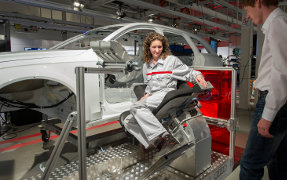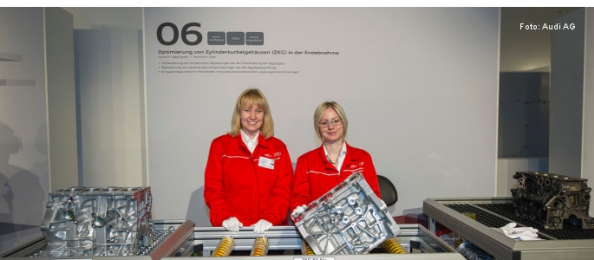At an ergonomics exhibition, employees of Audi Hungaria in Győr demonstrate a roller conveyor developed in-house. It can be used to easily position and rotate heavy workpieces such as an engine block (approx. 30 kg) without having to lift them.
Trendsetter for Ergonomic Workplaces in Industry
German society is in the throes of rapid demographic change, with the share of older workers rising steadily. At present, 40- to 49-year-olds account for approximately 32 percent of the workforce at AUDI AG, making them the largest group of employees. In just a few years, however, 50- to 59-year-olds will account for more employees than any other age group, and the share of employees over 60 will rise to approximately 13 percent.
Audi has set itself the goal of becoming the company with the most attractive and most productive workplaces by the year 2020. In light of the demographic shift and the far-reaching changes taking place in the working world, this goal can only be reached when employees maintain their ability to perform and stay competitive throughout their careers. Audi has therefore developed the ergonomics strategy “We for us. Active into the Future” with five areas for action: holistic ergonomic methods, intelligent work organization, ergonomics in the product process, internationalization, and accompanying communication.
Holistic ergonomic methods
From a holistic standpoint, preserving employees’ physical health and emotional well-being are equally important goals. In order to reach these goals, many environmental work factors must be taken into consideration. As the significance of mental illness is steadily increasing in society, companies must find a way to combat this trend while also focusing on employees’ well-being at work. After all, employees who perform their tasks with a sense of joy and enthusiasm and feel comfortable at work seldom become mentally ill.
A holistic standpoint takes into account not only more abstract-sounding factors such as work complexity and communications behavior, but also aspects of great practical relevance, such as how lighting conditions influence employees’ sense of well-being.
To ensure optimum lighting conditions, for example, the majority of the north wall of the new body shop for the Audi A3 at the Ingolstadt site has been made of glass. In addition, 3,000 daylight-controlled lights in the hall bathe this working space for some 800 employees in pleasant light. A small rooftop garden provides employees with the perfect spot to relax during daytime breaks. The exhaust and ventilation system is setting standards as well. All work steps that generate gases are performed by robots in closed cells. The ventilation system exchanges 1.6 million cubic meters of air each hour.

Photo: Audi AG
Intelligent work organization
The concept of group work was implemented in Audi manufacturing activities more than 20 years ago. One key component of group work is the rotation principle, meaning that employees switch activities every two hours. Audi is currently pursuing several approaches for placing even greater emphasis on ergonomics in group work in the future. One goal is the implementation of a stress-optimized rotation schedule based on occupational health criteria. After all, rotation only makes good ergonomic sense when strain is placed on alternating areas of the body. The concept will take into consideration qualification-related and socio-demographic factors, such as activities for employees with impaired abilities.
Ergonomics in the product process
Audi takes ergonomics into account early on in the product process during concept and parts development. As soon as the first parts have been designed, engineers frequently use high-tech tools such as the Cave, a virtual reality system, to simulate installation and assembly processes in three-dimensional space. However, the ever-growing complexity of the models means that there are always new challenges to overcome, such as the question of the maximum force employees can apply when installing the clip for the visor on the A3 assembly line without risking damage to their health. In order to make this process more sustainable, Audi is instituting ergonomic criteria that can be assessed as early on as during the component design process. A key indicator system is currently being developed for this purpose and will contribute to continuous improvement of the Audi standard.
Internationalization
In order to ensure high quality in production around the globe, it is also necessary to apply the same ergonomics standards worldwide. A global ergonomics network must be established for this purpose. Specifically, experts at sites in other countries must be selected and trained to bring the topic of ergonomics to the employees’ attention and make it an integral part of day-to-day work. The tasks are numerous and diverse. For example, people in Mexico, where Audi is currently building a new production site, have a different average body size than people in Central Europe. This means it is necessary to adapt the standards that apply in Europe, such as for the height of shelves.
Excellent working conditions are the only way to ensure premium Audi quality worldwide. Low wage levels and the availability of young workers does not mean that human resources should be treated with any less care. No matter if in Ingolstadt and Neckarsulm in Germany, San José Chiapa in Mexico, or Győr in Hungary, the focus is on people. The different legal systems in the various countries must also be taken into account during the establishment of the worldwide ergonomics network. For instance, a workplace structural analysis tool (APSA), which is already well established in Germany and has proven successful there, will soon be installed in Győr as well. It is used to analyze and evaluate physical strain in production workplaces, which includes aspects of load handling, physical strength, and constrained postures. In order to prepare a complete and detailed requirements profile for a workplace, the analysis also takes into account general criteria such as fixed cycle times and whether a workplace is a standing or a sitting one. These criteria are coordinated in such a way that Audi’s company physicians can compare them with their occupational health assessment criteria and immediately determine which workplaces are suitable or unsuitable for an employee with a certain diagnosis. The healthcare department at Audi’s Hungarian site in Győr and the colleagues from Ingolstadt are currently working on aligning the typical categorization used for occupational health examinations in Hungary based on statutory regulations there with the workplace evaluation criteria in the APSA.
As soon as all of the criteria have been aligned, colleagues in Hungary will also be able to instantly determine which workplaces are suitable or unsuitable, according to Hungarian standards for an employee with a certain diagnosis.
| Initiator | Audi AG |
| Status | ongoing |
| Region | Germany, Hungaria |
| Contact persons | Prof. Dr. Ing. Peter F. Tropschuh, Birgit Horn |
| Anti-Corruption |
|
| Business & Peace |
|
| Development |
|
| Environment |
|
| Financial Markets |
|
| Implementing UNGC Principles in your Corporate CSR Management |
|
| Human Rights |
|
| Labour Standards | X |
| Local Networks |
|
| Advocacy of global issues |
|
| Business opportunities in low income communities/countries |
|
| Project funding |
|
| Provision of goods |
|
| Provision of services/personal | X |
| Standards and guidelines development | X |
Dr. Peter F. Tropschuh is Head of Corporate Responsibility of Audi AG.
The Audi Group, comprising the two brands Audi and Lamborghini, has for many years been one of the world’s leading carmakers in the premium and supercar segment. Through the acquisition of DUCATI MOTOR HOLDING S.P.A., Bologna (Italy), and its subsidiaries, the Audi Group has moreover since July 2012 been able to offer its customers motorcycles built by one of the most successful manufacturers in that segment.
Write a comment about this page
Your comments are provided by your own free will and you take sole responsibility for any direct or indirect liability. In order to maintain the highest discussion quality, all comments will be reviewed by our editors. You hereby provide us with an irrevocable, unlimited, and global license for no consideration to use, reuse, delete or publish comments in accordance with our Community Guidelines.
About Us // Privacy Policy // Copyright Information // Legal Disclaimer // Contact
Copyright © 2012-2018 macondo publishing GmbH. All rights reserved.
The CSR Academy is an independent learning platform of the macondo publishing group.









